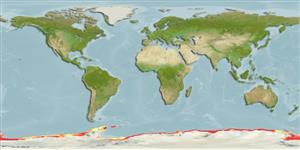>
Perciformes/Notothenioidei (Icefishes) >
Nototheniidae (Cod icefishes) > Trematominae
Etymology: Trematomus: Greek, trematos = hole + Greek, tomo = section, cut (Ref. 45335).
Eponymy: Professor Axel Johan Einar Lönnberg (1865–1942) was a Swedish zoologist who mainly worked at the Vertebrate Department of the Swedish Museum of Natural History in Stockholm. [...] (Ref. 128868), visit book page.
More on author: Regan.
Issue
The genus Pseudotrematomus is a synonym of Trematomus, which is confirmed by a molecular study to be published (J.-C. Hureau, pers. comm. 08 Jun. 2010).
Environment: milieu / climate zone / depth range / distribution range
Ökologie
seewasser bathydemersal; tiefenbereich 0 - 1191 m (Ref. 45168), usually 65 - 832 m. Deep-water; 61°S - 78°S, 180°W - 180°E
Southern Ocean: coasts of Antarctic Peninsula, Queen Mary, Adelie, South Victoria Coasts, Davis, Ross and Weddell seas.
Size / Gewicht / Alter
Maturity: Lm ? range ? - ? cm
Max length : 30.0 cm SL Männchen/unbestimmt; (Ref. 5179); common length : 20.0 cm NG Männchen/unbestimmt; (Ref. 45168); max. veröff. Gewicht: 357.40 g (Ref. 124149)
Rückenflossenstacheln (insgesamt) : 5 - 7; Rückenflossenweichstrahlen (insgesamt) : 31 - 35; Afterflossenweichstrahlen: 31 - 35. Body brownish, fins darker except first dorsal. With 4 or 5 irregular darker cross-bars, inside of mouth and branchial cavities blackish (Ref. 11892).
Found more commonly at depths greater than 300 m. Adults feed on amphipods (mainly Orchomene plebs), errant polychaetes, and in lesser amounts, fishes. Isopods and other crustaceans are probably included in the diet.
Dewitt, H.H., P.C. Heemstra and O. Gon, 1990. Nototheniidae. p. 279-331. In O. Gon and P.C. Heemstra (eds.) Fishes of the Southern Ocean. J.L.B. Smith Institute of Ichthyology, Grahamstown, South Africa. (Ref. 5179)
IUCN Rote Liste Status (Ref. 130435: Version 2024-1)
Bedrohung für Menschen
Harmless
Nutzung durch Menschen
Fischereien: nicht kommerziell
Tools
Zusatzinformationen
Download XML
Internet Quellen
Estimates based on models
Preferred temperature (Ref.
123201): -1.9 - 1.2, mean -0.9 °C (based on 2083 cells).
Phylogenetic diversity index (Ref.
82804): PD
50 = 0.5005 [Uniqueness, from 0.5 = low to 2.0 = high].
Bayesian length-weight: a=0.00427 (0.00266 - 0.00685), b=3.25 (3.11 - 3.39), in cm total length, based on LWR estimates for this species & Genus-body shape (Ref.
93245).
Trophic level (Ref.
69278): 3.3 ±0.48 se; based on food items.
Widerstandsfähigkeit (Ref.
120179): mittel, Verdopplung der Population dauert 1,4 - 4,4 Jahre. (Fec = 5,900).
Fishing Vulnerability (Ref.
59153): High vulnerability (61 of 100).
